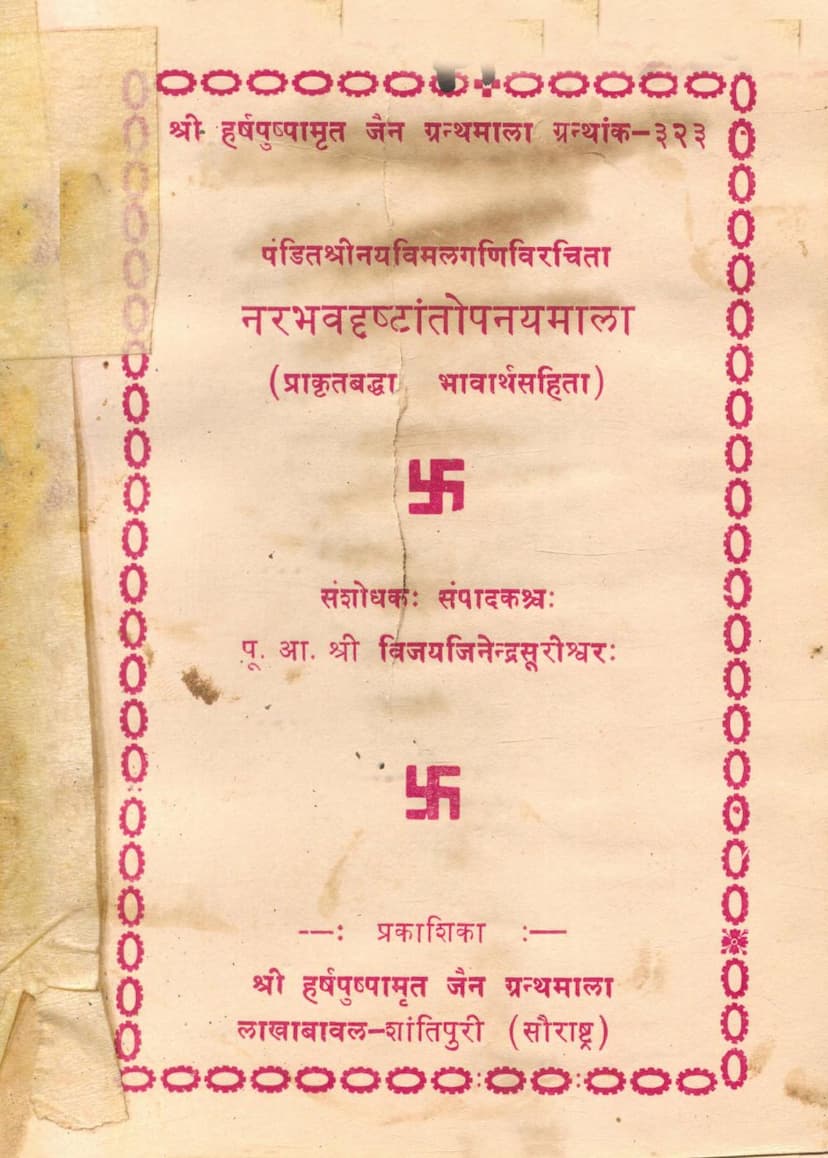Narbhavdrushtantopnaymala
Added to library: September 2, 2025

Summary
The book "Narbhavdrushtantopnaymala" by Jinendrasuri, published by Harshpushpamrut Jain Granthmala, is a significant Jain text that emphasizes the extreme rarity and preciousness of human life. The text, originally composed in Prakrit by Pandit Shree Nayvimalgajani, with commentaries and editing by Shree Vijayjinendrasurishwarji, is presented here with Gujarati explanations.
Core Message:
The central theme of the book is to illustrate how difficult it is to obtain a human birth, even after going through countless cycles of existence in various life forms and realms (hellish, animal, and celestial). The author uses a series of ten analogies (drushtanta) to drive this point home.
The Ten Analogies (Drushtanta) and their Core Ideas:
The book systematically presents ten analogies, each highlighting the rarity of human birth by comparing it to common or valuable items that are difficult to obtain:
- Chullak (Food): Just as obtaining good food can be difficult at times, so is obtaining a human birth.
- Pasak (Dice): Similar to how winning at dice is a matter of chance and often difficult, obtaining a human birth is also a matter of rare fortune.
- Dhanya (Grain): The difficulty of separating pure grain from chaff or finding a specific grain from a large pile mirrors the difficulty of obtaining a human birth.
- Jua (Gambling): Winning in gambling is extremely rare and often leads to ruin, much like the rare chance of obtaining a human birth amidst the struggles of existence.
- Ratna (Jewels): The immense value and rarity of precious jewels, like finding a wish-fulfilling jewel, are compared to the extreme rarity of a human birth.
- Swapna (Dream): The ephemeral and often unattainable nature of dreams serves as an analogy for the fleeting and hard-to-achieve human birth.
- Radha-vedh (Target Practice): The precision and skill required to hit a specific target, like the "Radha" in archery, represent the challenging and rare achievement of a human birth.
- Kurma (Tortoise): The analogy of a tortoise's head emerging from the ocean to find a yoke is used, highlighting how rare it is for a soul to emerge from the vast ocean of existence into a human birth.
- Yugashamila (A specific tool/combination): The difficulty of combining specific elements or tools, like a "Yugashamila," symbolizes the complex and rare combination of factors needed for a human birth.
- Parmanu (Atom): The infinitesimal size and immense difficulty of bringing together individual atoms to form something substantial, like a mountain, represent the extreme rarity of a human birth.
Structure and Content:
- Purpose: The book aims to impress upon the reader the profound significance of human life as a unique opportunity for spiritual progress and liberation (moksha).
- Content: Each analogy is presented with a narrative or a descriptive passage in Prakrit, followed by a detailed explanation in Gujarati. The stories often involve kings, ministers, merchants, and common people, illustrating the concept through relatable situations.
- Author's Lineage: The text meticulously traces the lineage of its compilers and commentators, emphasizing the unbroken tradition of Jain scholarship.
- Commentary: The included "Bhavarth Sahita" (with meaning) provides clear explanations of the Prakrit verses, making the text accessible to a wider audience.
- Spiritual Significance: The underlying message is that human life is a rare chance to practice Jain principles, accumulate merit, and ultimately break free from the cycle of rebirth. The text encourages diligence, detachment, and righteous conduct to make the most of this precious human existence.
In Summary:
"Narbhavdrushtantopnaymala" is a didactic work that uses evocative analogies to underscore the extreme rarity of human birth within the Jain philosophical framework. It serves as a potent reminder for spiritual practitioners to value their current existence and utilize it for righteous deeds, spiritual discipline, and the ultimate goal of liberation.